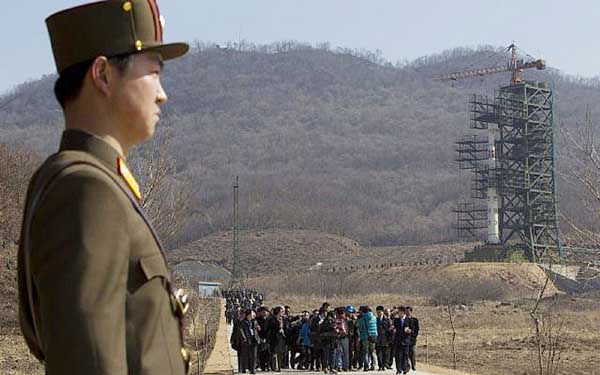
AFP, Washington :
US intelligence agencies have found that North Korea is building new missiles, based on satellite photographs taken in recent weeks and other new evidence, The Washington Post reported on Monday.
Just weeks after a high-stakes summit between President Donald Trump and North Korean leader Kim Jong Un, Pyongyang appears to be developing at least one or two liquid-fueled intercontinental ballistic missiles, the Post said, citing officials familiar with the intelligence.
The factory outside Pyongyang in Sanumdong where the work is underway produced the North’s first ICBMs capable of reaching the United States.
Following the Singapore summit in June, Trump had declared that Pyongyang was “no longer a Nuclear Threat,” and touted his own diplomatic achievements.
But Kim did not publicly promise to end work at the country’s nuclear and missile facilities, instead speaking of eventual denuclearization.
The reported new missile construction follows Secretary of State Mike Pompeo’s testimony last week in which he told senators Pyongyang continues to make nuclear fissile material, without indicating whether the hermit state was building new missiles.
Imagery from the National Geospatial-Intelligence Agency suggests ongoing work on at least one Hwasong-15 ICBM at the Sanumdong plant, the Post said.
“We see them going to work, just as before,” a US official told the newspaper.
But at the Sohae Satellite Launching Station on North Korea’s west coast, workers can be seen dismantling an engine test stand, in line with a promise made to Trump at the summit, though the move is seen as more symbolic since the facility can easily be rebuilt.
An image taken on July 7 shows a bright-red covered trailer in a loading area that appears to be identical to those vehicles the North has previously used to transport ICBMs.
The White House did not respond to the reports, saying it did not comment on intelligence.
A senior official from South Korea’s presidential office also declined to comment, but told Reuters that US and South Korean intelligence agencies were closely monitoring the North’s movements.
Joel Wit, a former State Department negotiator and founder of 38 North, a North Korea monitoring project, said on Twitter that it was “unrealistic” to expect Pyongyang to stop its programs “until the ink is dry on an agreement.”
Until the ink is dry on an agreement it’s unrealistic to expect the DPRK to stop its programs. That was certainly the case during the Cold War when the US and USSR continued to build missiles and nuclear weapons even while negotiating arms reduction agreements.
The reports of renewed activity follow Kim Jong Un’s pledge at last month’s summit in Singapore to work towards denuclearization. Donald Trump later declared that North Korea was “no longer a nuclear threat.” But despite these seemingly positive developments, Pyongyang has offered few concrete details about what denuclearization actually involves. It’s also not clear if US and North Korean officials even agree on the definition of denuclearization.
Denuclearization doubts: The satellite imagery is not the first sign that North Korea may be continuing development at its nuclear and missile facilities. In June, senior officials cited by US media said intelligence agencies believed North Korea had no intention of giving up its nuclear arsenal, and that the state had increased production of fuel for nuclear weapons. US Secretary of State Mike Pompeo also reported last week that the North was continuing to make fuel for nuclear bombs despite its pledge to denuclearize.

